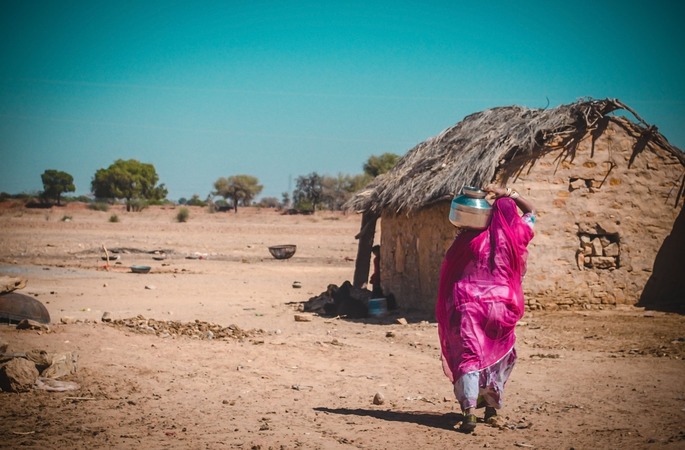Dumka, Jharkhand
Witch-hunting is one of the worst forms of human rights violation. Since historic times, this evil practice in India has resulted in sexual harassment, atrocities, and the murder of thousands of women. In rural areas where literacy levels are low, gender norms are rigid, and women are taught not to fight back, the situation is grim. According to National Crime Records Bureau (NCRB) data from 2008 to 2013, Jharkhand – a state in eastern India, ranks first in the country in terms of murder of women after accusing them as Witches’ Daain’. The rural areas of Jharkhand, mainly the tribal regions, are involved in this practice. West Singhbhum, Dumka, Godda, Deoghar and Khunti of Jharkhand are some districts infamous for witch-hunting.
Women suspected of causing negative influences are branded as witches and are hounded by villagers. They are force-fed human excreta, urine and are raped, paraded naked through the village, their head is shaved, beaten by women, men and children. In several cases, they are tied to a tree, and their genitals are hit with sticks, subsequently killing these women. These are a part of the horrendous reality that persists in India as a ritual to murder a woman accused of being a witch.
These abominable acts are carried out under the guise of death of someone who was unwell due to a chronic disease, damage to the crops, family disputes over property, death of a child in the womb or when a woman claims her right to land. Thus, either the whole family or a childless elderly woman is killed in this scheme or else she is banned by the entire village forced to live a life full of miseries.
According to a report, in 2018, 26% of people killed in India on suspicion of practising witchcraft were from Jharkhand. The report also stated that 27 deaths related to allegations of witchcraft were reported in 2019 as per the data provided by the state police.
The target is usually widows, childless women, women of lower caste or older women. These vulnerable women are targeted, either with the intention of illegally grabbing their land or property or the occurrence of any mishap in their area. For example, in the year 2004, the villagers found a burnt dead body of a man of Mahuasol village in Godda district, Jharkhand. Some of his body parts were missing. Veiled by sheer superstition, villagers accused two middle-aged women of being witches and burnt them alive. Similarly, about 35 women have been killed in the last five years in the West Singhbhum district of Jharkhand.
Although awareness campaigns are being conducted continuously by the government, voluntary and social organisations in these areas, witch-hunting is on the rise and not ending. Since the formation of the state, 1200 women have died so far in such incidents.
Poor health care is a major contributor to the existence of witch-hunting. As most of the population of the state stays in the countryside, where the distance between public health care and the villages is a barrier, Ojha, a healer who believes in supernatural powers, becomes the curer for most people. With a low literacy rate and poor health care facilities, the people are easily instigated by the Ojha’s, resulting in high numbers of witchcraft deaths.
To curb the deaths of women under witchcraft, as of now, no specific and particular national-level legislation has been enacted to penalise it. However, in 2016, The Prevention of Witch Hunt Bill 2016 was introduced by Raghav Lakhanpal in the parliament, but the fate of this bill remains pending. Hence, the provisions under the Indian Penal Code 1860 (Sec. 302 which charge for murder, Sec. 307 attempt for murder, Sec. 323 hurt, Sec. 376, which penalises for rape and Sec. 345, which deals with outraging a woman’s modesty) are used as an alternative for the victim. In addition, special laws are in place for states like Bihar, Rajasthan, Jharkhand, Chhattisgarh and Assam, which have an increasing number of female deaths due to witch-hunting.
When it comes to Jharkhand, the state has brought in the Prevention of Witch (Daain) Practices Act, 2001, to tackle the issue specifically. However, the Act does not make any difference to the growing atrocities against women in the state. According to a report, the Act remains toothless with provisions for a minimal jail term and a minor financial penalty. The Act states that someone harming a person by identifying them as a witch are liable to face action under the law. It also outlaws anyone branding a person a witch or Daain. However, the punishment remains a small fine of Rs 1000-2000 or imprisonment of three months to one year. Hence a stop to the practice becomes merely impossible.
Furthermore, the Jharkhand police stated the Act’s inadequacy in a report on their official website. The report says, “Clearly, section 3, 4, 5 and 6 comprising the penal provisions of the Act are woefully inadequate for deterring or punishing those responsible for branding and persecuting women as witches. Given the severity of the outcomes of identification, abetment in identification, and curing or ‘witches’, which almost inevitably lead to horrific crimes being committed against the women so identified, including death, inhumane treatment, bodily mutation, rape and various forms of mental and physical torture, the penal provisions of the Act do not adequately punish the instigators of these crimes or prevent others from engaging in these crimes.”
Hence, despite the existence of this law, women accused of being witches are persecuted, murdered, and tortured in Jharkhand even today. Therefore, a reliable mechanism to prevent the killing of innocent people, increase the literacy levels of the rural population, and, most crucially, enhance the rural health care system should be a key priority. After all, how long women would bear the brunt of social ills?



